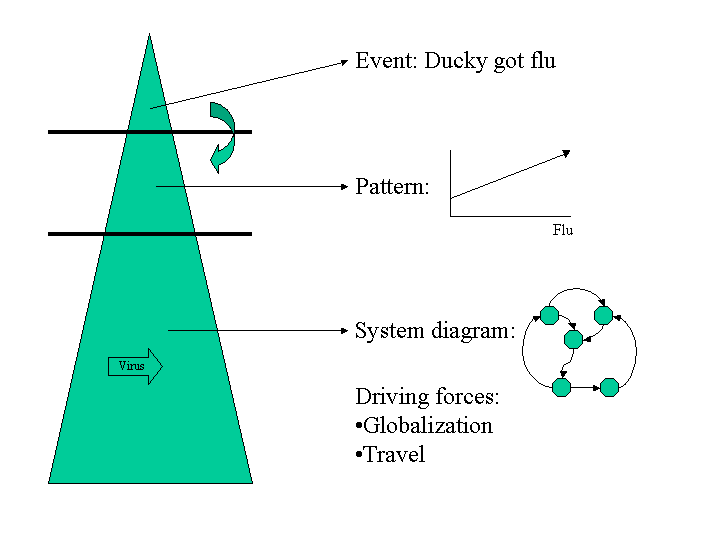RSM EMBA 2005 Class Notes
Class 1
Anthology: How --- Epistemology: What
Process: How / The way --- Content: What
In a lot of discussions in business process and content are confused.
Important in scenario thinking is the way a manager thinks, not the report.
Equally important is content.
KNOW YOUR STUFF!!
Drivers of scenario thinking:
- What are we missing?
- What don’t we know?
Workshops are needed to decide for what time period you make scenarios (1 or 2 workshops)
Complex things require complex presentation.
Story telling works, bullets don’t!
Best scenarios have high surprise and high likelihood.
Everything you do is based on assumptions of the future.
Only 2-3% of time of managers is spend on thinking about the future.
Focussing for a long time give fresh insights.
Value of scenarios is not in business as usual, because managers are capable of doing that, but in extraordinary information.
Class 2
Difference is explained between:
- Dilemma – A choice between two
- Scenario – what do we want to understand
Strategy is about problems you don’t know about
Operations is solving problems of today
Strategy is not about what you do, but about what you NOT want to do.
Story about alchemy has as learning points:
- Divide / reductionism throws away valuable information
- Systems are worth saving
Politics, Economics, Social and Technology are interconnected.
Characteristics of systems and scenarios:
- A system is more defined by the nature of interrelationships than by the objects itself.
- Systems and scenarios provide an ability to test and to play.
- Scenario collects a set of assumptions.
Tips for system development:
- Boundaries in systems are arbitrary. It is a choice.
- When making scenarios you choose your boundaries! Don’t choose the boundaries too strict.
- Granularity in a system is a choice. It is better to model in richness.
- Nodes in a system which have only incoming, or only outgoing arrows should be split up.
- Software – Stella and iThink can help in modelling and showing system dynamics.
- Describe every link in a system (in natural language), and read as a sentence.
Ways to change the behaviour of a system:
- Change rules of the system
- Intensify the system until it collapse
- Change a high leverage point
- Change everywhere at once
A system for the war against drugs of Ronald Reagan was developed in the class. (I do not have the systems diagram) Interventions which could help to solve this problem are:
- Legalize and tax
- Buy-out farmers
- Substitutes
- hapiness
- Kill users
Class 3
Session 3
Homework and assignments:
Learning log (due date December 1st, 2005):
- Academic reflection – on readings
- Professional reflection: Do scenarios help? What kind of problems do you expect in your business which can be clarified by using scenarios?
- Personal reflection: Do you care? Personal development, career, group – related to Myers Briggs
2000 words - make every word count. Be creative!
Per person of the group create 2-3 driving forces related to your groups assignment.
Traffic in Mexico – city congestion problem – make a system to solve the traffic problem in Mexico. The following choices are available to solve the problem:
- New railway
- New subway
- New highway
Quotes:
- Messy situations require messy representation!
- Never argue from a specific ‘lens’ (sociology, economics, politics,…)
- Thinking is free
- Systems are a representation
- If a perceived idea is confirmed BE AWARE!
- Operations research is suitable for defined problems, not for messy problems.
- ‘The name of the devil is sub-optimisation’ – Gharajedaghi
- ‘Your hand is not as dumb as the idiot you are’
Events -> Patterns -> Driving forces -> Systems scenarios
To get from a system to the next level:
- Focus on research questions.
- Feedback loop on research – new questions, better answers.
- Ongoing process.
- Than frame research as driving forces
- Make new systems diagram
Driving force title should always indicate a direction, and should answer the questions where, for what, and in what context. A driving force title should be specific.
Example:
Reasonable driving force – ‘Increase in oil price’
Better - ‘Increase of total consumption of oil’
To go from ‘The official future’ to ‘Reality’:
1. Vision of the CEO
2. Workshop where a shared mental model is created (a construction)
3. Do research to go from construction to reality
Use reality in the scenarios.
Three choices to get from a new systems diagram to scenarios:
1. Find high leverage point, for example by using a voting system. If the high leverage point changes the whole diagram changes.
2. Big stories – tell 5 to 6 big stories using the system diagram. Reduce these to 3-4 scenarios
3. Walk and talk – move through the environment. Answer in this walk the questions ‘What do we want to say?’ and ‘What do we want to know?’
Define what is uncertain:
- Why on what does it depend?
- What happens if it happens?
